Morocco made history, after finishing first in the group at the 2022 World Cup in Qatar, being the first African team to do so since Nigeria in 1998.
At that time, they shared the group with Spain, Paraguay and Bulgaria. The Africans grabbed also surprising victories over Spain. However, they finished with 6 points, and Morocco did so with 7,
A 0-0 draw against world runners-up Croatia, followed by a 2-0 victory against a powerful Belgium and ended with a new 1-2 victory against Canada. The defensive solvency and threat on the counterattack added to the technical quality of its players, making the selection of Walid Regragui a special one.
Canada, for its part, after an extremely positive start in terms of performance, against Belgium, seemed that it was going to offer us much more, but it was not like that. A crushing defeat by 4-1 against Croatia would leave them out of the knockout phase and still to play this last game like this with certain changes in the squad of some starting players.
In this tactical analysis, we dive into the tactics of both teams in form of analysis and see how Walid Regragui made early history with Morocco in the World Cup.
Lineups
Canada deployed to 4-4-1-1 with Milan Borjan in goal; A back-four made up of Alistair Johnston, Steven Vitória, Kamal Miller and Sam Adekugbe. In midfield, the double pivot of Jonathan Osorio-Mark Kaye was flanked by wingers Tajon Buchanan and Alphonso Davies.
The forward was formed by Junior Hoilett and Cyle Larin.
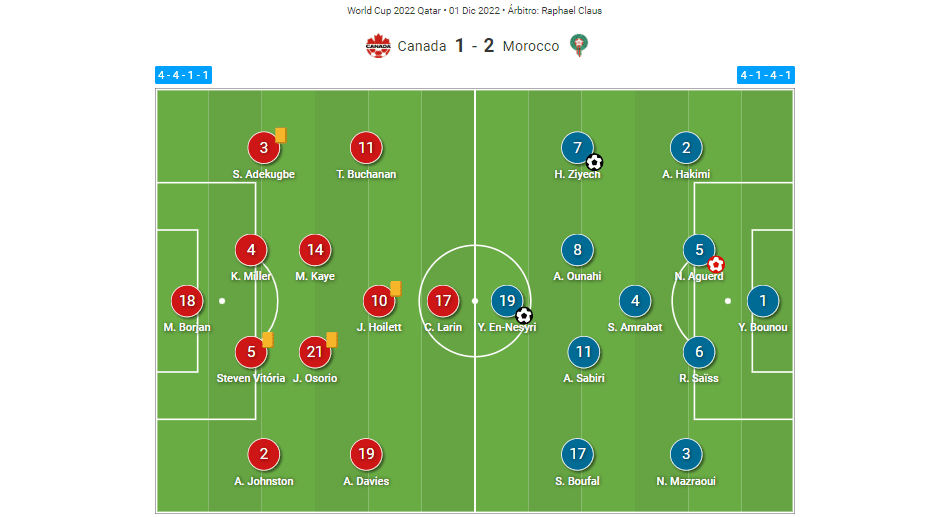
Morocco went with their 4-1-4-1, with Yassine Bounou on goal; Noussair Mazraoui, Romain Saïss, Nayef Aguerd and Achraf Hakimi on the defence; Sofyan Amrabat as a lone midfielder, Abdelhamid Sabiri and Azzedine Ounahi as the advanced midfielders, ending the starting eleven with Sofiane Boufal, Hakim Ziyech and Youssef En-Nesyri up top.
Morocco’s brave and rigid block, joined by rapid counter-attacks
Walid Regragui’s Morocco executed a wonderful plan to finish first in a group and be one of the early surprises of the 2022 World Cup. As they have already shown in their two previous matches, defensive coordination is the key to their success.
First, there is defensive solvency and covering the spaces that an opponent can take advantage of, and then looking for the goal. That is why so far, they have only conceded one goal.
Canada felt the blow in the first minutes with Hakim Ziyech’s goal at minute 5′, however, it was not only the 0-1 that left them confused, but they had very little space and options to generate football within their idea and principles to attack.
Only in the first half of the match, they had a shot which was two minutes before Morocco’s first goal. It wasn’t until minute 58 that they were able to finish off again since their goal was at minute 40′, this being an own goal by Nayef Aguerd.
Faced with the technical gestures and brushstrokes that the Moroccan players were leaving, their direct football that was played at first patiently, then in a matter of seconds evolved into quick one-touch plays and ended in dribbles, and luxurious details from Sofiane Boufal or Hakim Ziyech, or long balls by their midfielders or centre-backs, Canada seemed nullified on the pitch, which it was for many minutes of the game, something unexpected after their recent performances at the World Cup.
In fact, despite the talent and quality of Hakim Ziyech, one of whom Regragui managed to return to the Morocco squad thanks to his appointment as coach a few days before the start of the World Cup. One of the players who has been surprising the most is former Southampton winger, Boufal.
That is constantly sought from the inside out by players like Sofyan Amrabat or Azzedine Ounahi, which commanded extremely fast transitions or organized attacks that in most cases looked to open after two-three touches to the outside.
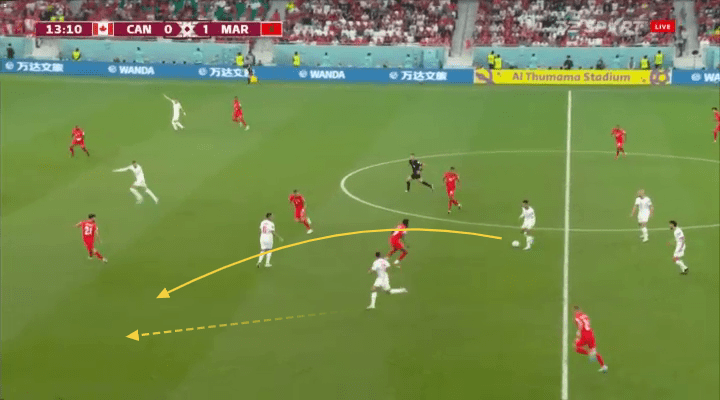
However, it is more than clear that Hakim Ziyech was going to be a fundamental player within the tactics of Regragui’s Morocco, as well as within what he can generate with his freedom and creativity to play with the ball at his feet.
Again, Morocco were constantly looking to launch passes from the inside to the wide areas.
Previously, Morocco played the ball very well from side to side, with a lot of patience to find the right pass to break through, something they constantly looked for, and from there accumulate between 2 and 4 quick passes, where the players limited themselves to giving a touch and subsequently open the pass to a winger.
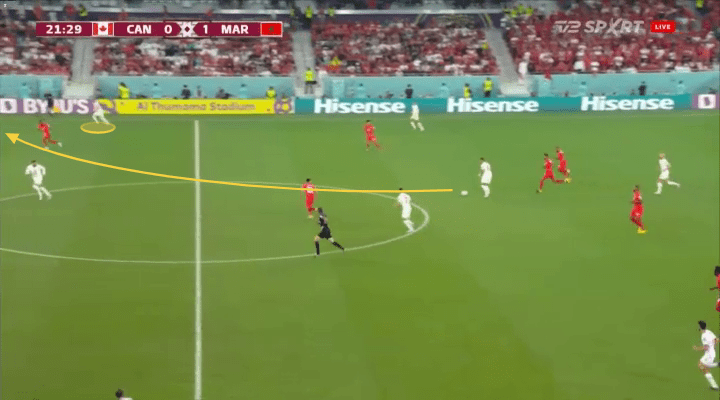
Not only did Morocco seek to generate like this, but they also tried to attract with their patient passes from side to side, from the central defenders who tried to find one of their full-backs, a little shorter, who show incredible technical quality to play, like Achraf Hakimi or Noussair Mazraoui, so that they then launched long passes to their teammate on the wing, or even to the striker.
A wonderful example of this is the second goal scored against Canada. They try to move John Herdman’s team side by side, pinning players in the middle for the winger, Hakimi in this case, to throw a long pass to En-Nesyri that finished in a big way.
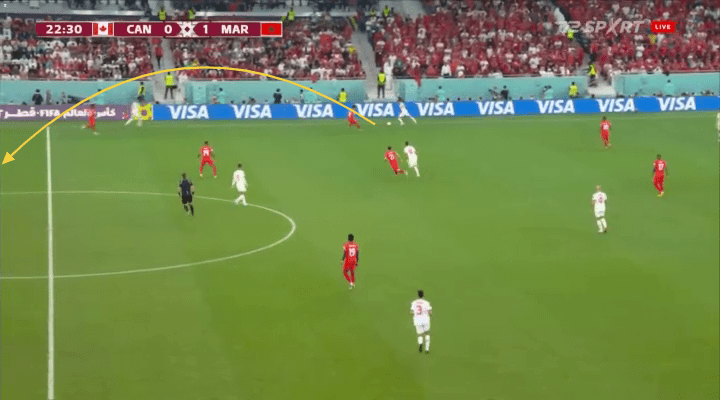
Even paying more attention to what their defensive block should anticipate, they found a third goal in the match but it was disallowed by offside, by the same En-Nesyri who was looking for his second of the night. However, he says a lot about what was the performance in attack directly by the Moroccan side.
But what has really stood out in this group stage for Morocco is its defensive aspect which, despite being a fairly rigid block, is aggressive and proactive at the same time, one could say, with a relatively high line that it contains many movements, coordination and adjustments between each of its players, in order to be more solid and much harder to break against so many things already prepared.
Canada found very few spaces in the match facing Morocco’s 4-1-4-1, which initially stopped like this in every organized attack by Herdman’s team, which were extremely flat and ineffective with the ball, passing it from side to side, and with few receptions between the lines.
Everything, obviously, thanks to the great work of the Moroccan players, and above all, Azzedine Ounahi and Sofyan Amrabat in midfield, each in their different roles.
In this 4-1-4-1, the wingers, Ziyech and Boufal were internalizing to play closer to their midfielders and congest these central channels, with the coverage of Sofyan Amrabat behind them, who provided a lot of security in this match and in the previous ones, to his entire team.
If the pass was played towards the rival full-back, one of the wingers on that side attacked it and was accompanied by either their teammate full-back that raised his position or one of the midfielders who moved the block towards that area.
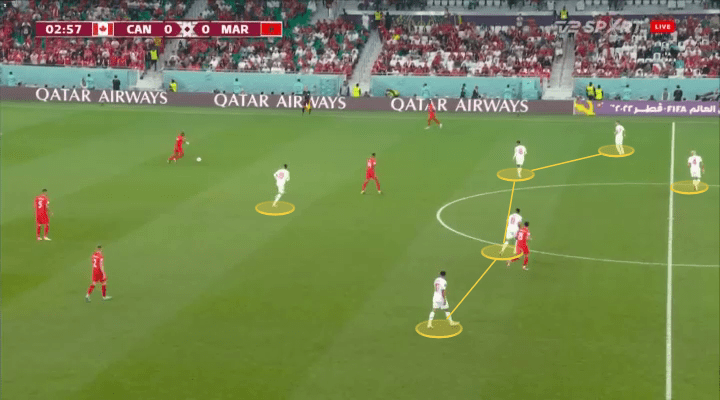
One of these coordinated movements of the defensive block were the typical jumps by Ounahi or Sabiri, where the ball was played on their side, thus forming a 4-4-2 that moved quickly and constantly to return or continue pressing forward.
This contained movements behind that made a lot of sense, since if one of the midfielders went up, the striker, in this case, En-Nesyri, went higher to cover a safe pass back while another of the midfielders took the rival #6, which was normally a marking responsibility of the Sevilla striker.
Just like is shown in the picture below, with one of the midfielders, in this case, Ounahi going off to mark the ball-holder, and Sabiri was then going to cover the rival pivot, as En-Nesyri went forward.
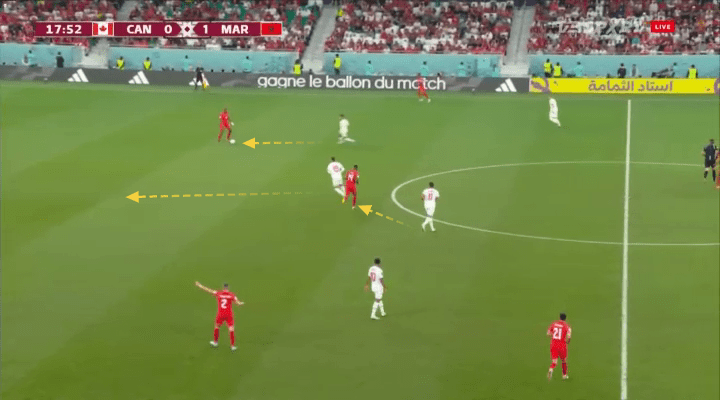
But if the ball managed to cross this first line of pressure, Morocco also had prepared movements and jumps in different channels that Canada sought to activate the ball through low passes and at the foot of the most advanced teammates.
When the ball was played between the half-space and closest to the wide zone, Sofyan Amrabat showed one of his best roles so far, the coverage of this zone. Therefore, he formed a defensive 2v1 or 2v2 that covered any numerical superiority that Canada wanted to look for on the outside.
There, Hakimi or Mazraoui also came out aggressively, to block and anticipate what can happen if they wait further back.
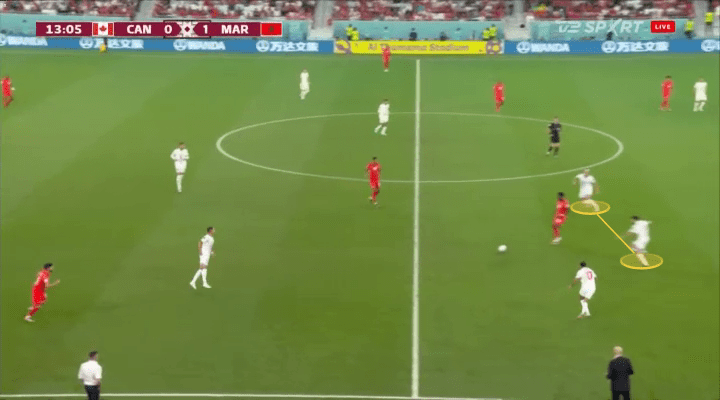
If the ball progressed purely through the half-space or the central channels of the field, the jumps of the centre-backs, Nayef Aguerd or Romain Saïss were key to eliminating all types of reception between the lines of the North American team.
On the other hand, Amrabat was also important since he either took the place left by the central defender who came out to defend or depending on how he saw everything, he stayed in his zone, covering possible passes that could be possible for the rival that was being defended under-pressure.
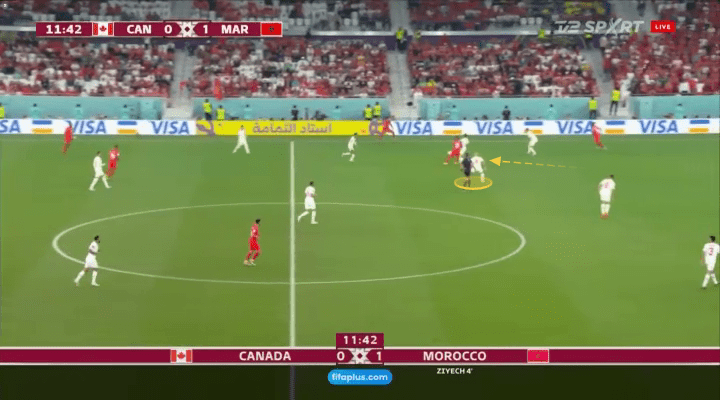
The coverage of ground and spaces became bigger and bigger during the game, from Sofyan Amrabat, who did not stop running all over the field during the 90 minutes trying to win the 3 points and defend the result at all costs and his nation.
The Fiorentina player had fully internalised and understood what he had to do tactically when Hakimi left, which normally greatly elevated his position in attack.
The ex-Verona covered this area and did it wonderfully, with great strength and intensity to reach each of his duels.
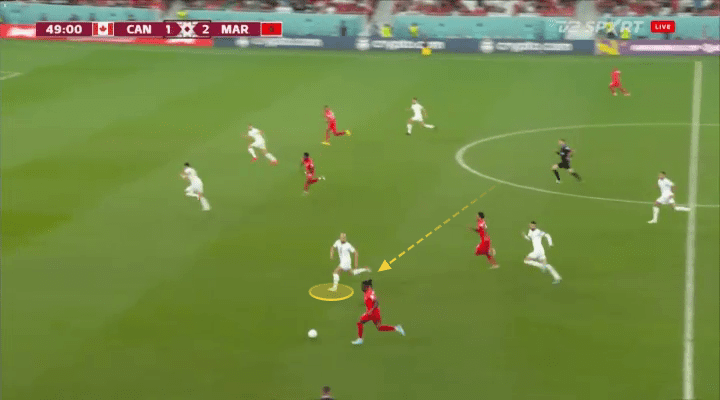
Conclusion
Morocco really showed that they can be one of the revelations of the tournament thanks to their defensive coordination, which has been really fascinating during the first three matches of the World Cup.
Now, they await the Round of 16 with a view to continuing to improve and play as united as they have done on the pitch under Walid Regragui’s mandate.






Comments